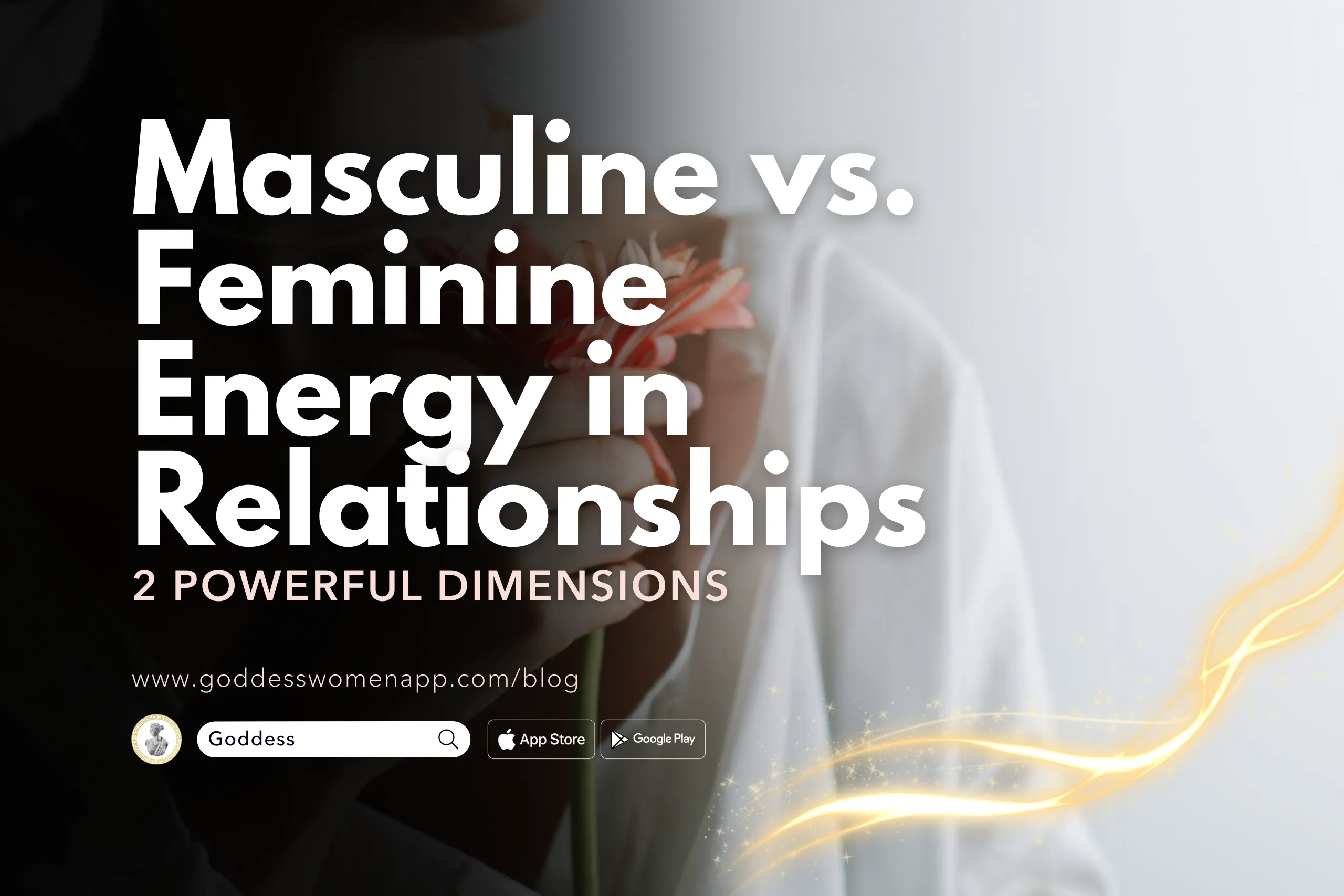Table of Contents
I. Introduction
In the intricate dance of relationships, the energies we bring to the table play a pivotal role in the rhythm and harmony we experience with our partners. Often, these energies are not about physical strength or appearance but about the essence of our being and how we interact with the world and our significant other. Understanding the concept of energy dynamics in relationships is akin to understanding the language of love and connection. It allows us to navigate the complexities of intimacy with grace and comprehension.
The terms masculine vs. feminine energy are frequently mentioned in discussions about personal growth and relationships. However, it’s crucial to note that these energies are not confined by gender; they are universal forces present within all of us, regardless of our gender identity. Understanding the interplay between masculine vs feminine energies is paramount for cultivating a fulfilling and balanced relationship. It’s not about men vs. women; it’s about understanding the essence of these energies within ourselves and how they complement or conflict with those of our partners.
This blog post aims to delve into the depths of “masculine vs. feminine energy in relationships.” We will explore the definitions, characteristics, and impacts of these energies on our relationships. By shedding light on these dynamics, we aim to provide insights that can lead to greater harmony, understanding, and love in our most cherished connections. Whether you’re in a relationship, seeking one, or simply interested in personal growth, understanding these energy dynamics can open doors to deeper connections and self-awareness.

II. Understanding Masculine vs. Feminine Energies
Masculine vs. feminine energies are forces that exist within all of us, transcending our physical gender. These energies are complementary and are meant to balance each other in harmonious interplay. However, misconceptions and societal norms often cloud our understanding of these energies, leading to imbalance and friction in our relationships.
Masculine Energy is often characterized by qualities such as assertiveness, logic, and protection. It’s the force that drives us to take action, to provide, and to solve problems. In its purest form, masculine energy is not about domination, but about being a pillar of strength and reliability. It’s the energy that builds structures and creates a sense of security. In relationships, healthy masculine energy can manifest as the ability to be present, to listen, and to offer support without necessarily trying to “fix” every issue.
On the other hand, Feminine Energy is often associated with intuition, nurturing, and creativity. It’s the energy of being, of receptivity, and of emotional wisdom. Feminine energy is what allows us to connect deeply with our emotions and the emotions of others. It’s the force that makes room for healing, understanding, and growth. In relationships, feminine energy offers the space for vulnerability and emotional bonding, fostering a deep sense of intimacy and understanding.
It’s important to note that these energies are not static; they are fluid and ever-changing. We all possess a unique blend of masculine vs. feminine energies, and our circumstances, moods, and experiences can shift the balance of these energies within us. Embracing both energies allows us to be more adaptable and resilient in our relationships.
When these energies are in balance, relationships can thrive. Masculine energy provides clarity and stability, while feminine energy brings warmth and flexibility. However, imbalances can lead to conflicts and misunderstandings. For example, an excess of masculine energy might manifest as insensitivity or over-dominance, while an overabundance of feminine energy might lead to passivity or emotional overwhelm.
In the following sections, we will dive deeper into the roles of masculine vs. feminine energies in relationships, explore how to cultivate balance, and discuss strategies to navigate the challenges that arise from these dynamic forces. Understanding and honoring both masculine vs. feminine energies can pave the way to more meaningful, harmonious, and fulfilling relationships.
III. The Role of Masculine Energy in Relationships (Masculine vs. Feminine)
Masculine energy in relationships often manifests as a grounding force, offering stability, protection, and direction. While it is easy to misconstrue this energy as domineering or unemotional, true masculine energy is neither oppressive nor detached. Instead, it provides a foundation of strength, reliability, and action that supports the growth and deepening of the relationship.
One of the most profound roles of masculine energy in a relationship is its capacity for providing structure. This isn’t about setting rigid rules or imposing strict limitations but about creating a safe, predictable space where the relationship can flourish. Masculine energy drives one to take charge of situations, make decisions when needed, and stand firm in the face of challenges. It’s about being a pillar of support, not just physically but emotionally and mentally, providing a sense of security that allows both partners to explore, grow, and express themselves fully.
Masculine energy also plays a crucial role in communication. It fosters a direct, clear, and objective style of expressing thoughts and feelings. This straightforward approach can help to cut through misunderstandings and resolve conflicts efficiently. However, it’s vital to balance this directness with empathy and understanding, ensuring that communication fosters connection rather than creating distance.
Common misconceptions about masculine energy often stem from cultural stereotypes that equate masculinity with insensitivity or aggression. In reality, healthy masculine energy is neither of these things. It’s about being present, accountable, and responsive to the needs of the relationship. It’s the energy that says, “I am here for you, and we will navigate this together.” When channeled positively, masculine energy provides a sense of safety and commitment that is indispensable for a thriving relationship.
IV. The Influence of Feminine Energy in Relationships (Masculine vs. Feminine Energy)
Feminine energy in relationships is often perceived as a nurturing, creative, and intuitive force. It is the energy of connection, emotion, and adaptability. Feminine energy is not about weakness or submissiveness; instead, it represents strength in vulnerability, wisdom in empathy, and power in understanding. It’s an energy that weaves the fabric of deep, emotional connections, turning a relationship into a profound, soulful union.
The nurturing aspect of feminine energy is one of its most powerful expressions. It’s an energy that says, “You are seen, you are heard, and you are cared for.” This energy manifests through empathy, compassion, and the capacity to support and uplift one’s partner. It’s about creating a safe, emotional space where both individuals feel free to be their true selves, express their deepest fears, and share their highest hopes.
Intuition is another hallmark of feminine energy. This intuitive sense goes beyond mere emotion; it’s about a deep, inner knowing and understanding of one’s partner and the relationship. It’s the ability to read between the lines, to sense what needs to be said or done to foster growth, healing, and harmony. Feminine energy is perceptive and receptive; it listens not just to words but to the silence between them, to the emotions beneath the surface, and to the unspoken needs and desires of both partners.
Despite its profound contributions, feminine energy is often misunderstood and undervalued. Common misconceptions frame it as overly emotional, weak, or indecisive. However, true feminine energy is anything but weak; it’s the source of immense strength, resilience, and adaptability. It’s the force that can transform vulnerability into connection, conflict into collaboration, and pain into growth.
In relationships, feminine energy complements masculine energy by offering balance, depth, and emotional richness. It invites openness, fosters mutual understanding, and nurtures the shared growth of both partners. By embracing and honoring feminine energy, a relationship can become not just a partnership but a sanctuary of understanding, love, and profound connection.
V. Balancing Masculine vs. Feminine Energy for a Harmonious Relationship
The dance of relationships is most harmonious when the energies of both partners are in sync and balanced. This balance between masculine vs. feminine energies is not about achieving a 50-50 static state but about creating a dynamic interplay where each energy complements and supports the other. When these energies are balanced, relationships thrive on stability, depth, passion, and mutual respect. However, achieving and maintaining this balance is a conscious and continuous effort.
Recognizing the need for balance is the first step. It requires an understanding that both energies, regardless of our gender, have their strengths and vulnerabilities. A relationship skewed too heavily towards masculine energy might become rigid and emotionally distant, while one overly reliant on feminine energy might lack direction and clarity. The key is to foster an environment where both partners feel free to express their true selves, embracing both energies in their actions and interactions.
Cultivating balance begins with self-awareness. Individuals must reflect on their own dominant energies and how these energies manifest in their relationships. Are you more inclined to take charge and solve problems, or do you naturally empathize and nurture? Understanding your natural tendencies allows you to consciously cultivate the opposite energy when necessary. For instance, someone with strong masculine energy might practice patience and active listening to enhance the feminine energy of receptivity and understanding.
Communication is another crucial strategy. Open, honest conversations about each other’s needs, feelings, and perceptions can help couples understand where imbalances might lie. These discussions can also set the stage for cooperative strategies to balance these energies. For example, if one partner feels overwhelmed by taking on too many responsibilities (an excess of masculine energy), the other partner can step in to share the load or provide emotional support, thereby introducing more feminine energy into the dynamic.
Correcting imbalances is a matter of both partners being willing to adapt and grow. This might involve setting boundaries, altering communication styles, or changing certain behaviors. It’s about creating space for each energy to thrive and ensuring that both partners feel valued and understood. Couples can also engage in activities that foster the opposite energy. For instance, those who feel they need more feminine energy might spend time in nature or practice mindfulness, while those seeking to boost their masculine energy might engage in physical activities or take on new challenges.

VI. Challenges and Misunderstandings in Energy Dynamics in Masculine vs. Feminine
Navigating the energy dynamics in relationships is not without its challenges. These challenges often arise from deeply ingrained societal norms, cultural expectations, and personal insecurities. Understanding and addressing these challenges is crucial for maintaining the balance and health of the relationship.
One common challenge is the societal stereotype that associates masculinity with strength and femininity with weakness. These stereotypes can lead individuals to suppress their natural energies, fearing judgment or rejection. For example, men might hide their emotional, nurturing side, while women might shy away from asserting themselves. Breaking free from these stereotypes requires courage and the conviction that strength lies in authenticity and balance, not in adhering to outdated norms.
Misunderstandings about what it means to be masculine or feminine can also create friction. For instance, a display of emotion is not a sign of weakness but a strength of feminine energy. Similarly, assertiveness should not be confused with aggression but seen as a positive aspect of masculine energy. Couples must strive to understand the true nature of these energies and appreciate their expressions in their partner.
Another challenge is the rigidity of roles based on these energies. Relationships are dynamic, and the flow of energies can change based on circumstances, moods, and stages of life. Being open to this fluidity and allowing each other to express the full spectrum of these energies enriches the relationship and fosters growth.
In conclusion, navigating the complexities of masculine vs. feminine energies in relationships requires understanding, patience, and a willingness to grow and adapt. By embracing both energies, individuals and couples can create relationships that are balanced, fulfilling, and rich in mutual understanding and respect.
VII. Conclusion on Masculine vs. Feminine
The journey through the intricate landscapes of relationships is profoundly influenced by the interplay of masculine vs. feminine energies. Understanding and balancing these energies is not merely an exercise in self-awareness but a transformative practice that can deepen connections, enhance mutual respect, and foster enduring love and partnership. Recognizing that these energies transcend gender and are present in each of us allows for a richer, more nuanced approach to our relationships.
Balancing masculine vs. feminine energies is akin to mastering a dance – it requires attentiveness, adaptability, and a willingness to flow with the music of life and love. A relationship grounded in this balance benefits from the stability and action-oriented nature of masculine energy and the nurturing, intuitive aspects of feminine energy. It’s a partnership where each individual feels seen, heard, and valued, a union where growth and understanding flourish.
As we close this exploration of masculine vs. feminine energy in relationships, it’s crucial to reflect on your own energy dynamics. Consider how your energies manifest in your relationships. Are they in harmony, or do they occasionally clash? Do you feel free to express both your masculine vs. feminine sides? Reflection is the first step toward transformation, and awareness is the precursor to balance.
Embracing both masculine vs. feminine energies in your relationship holds the potential for profound transformation. It’s a journey of continuous learning and adaptation, but the rewards are immeasurable. A balanced relationship is a canvas where love, respect, and understanding create a masterpiece of shared experiences and growth.
For those seeking to embark on this journey of balance and transformation, the Goddess App offers a sanctuary. It’s a space where you can explore, learn, and grow in your understanding of energy dynamics in relationships. The Goddess App provides resources, support, and a community of like-minded individuals all striving towards harmony in their relationships and within themselves.
Take the first step towards a more balanced, harmonious relationship today. Download the Goddess App, and join a community dedicated to embracing the full spectrum of energies that make our relationships truly enriching and fulfilling. Together, let’s unlock the transformative potential of balancing masculine vs. feminine energies in our lives and relationships.





